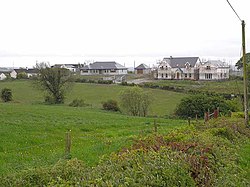Corduff
| Corduff Irish: An Chorr Dhubh | |
| County Dublin | |
|---|---|
 Houses at Corduff | |
| Location | |
| Grid reference: | O083399 |
| Location: | 53°23’53"N, 6°22’18"W |
| Data | |
| Post town: | Dublin |
| Postcode: | D15 |
| Dialling code: | 01 |
| Local Government | |
| Council: | Fingal |
| Dáil constituency: |
Dublin West |
Corduff is a north-western suburb of Dublin, in County Dublin. It is located near Blanchardstown. It is also a townland of the county.[1]
History
One of the earliest references to Corduff is in a document from the reign of Edward VI, dated 2 August 1547, which records a “lease to James Walshe of London, gent., of the rectory of Malahydert, County Dublin, and the tithes &c. in Malahydert, Culduff, Bossardston, Pasloweston...Tyrrolstown, Abbatiston...".
Evolution of the name
The name of the village has varied over time. The form Culduff and significantly, Cooleduff (this last in the census of 1659) is the predominant one down to the early years of the 18th century. In the Civil Survey, compiled in the mid-1650s is found a notice of "Colduff, ½ a plowland, 143 acres, [property of] Will. Warren, Irish Papist ... There is upon ye premisses a stone house slated, one barne and stable tathct, severall cottages ... a small orchard and garden with a grove of ash trees, one mill in use worth Anno 1640 ten pounds per annum. The Tythes belong to ye Colledge of Dublin [i.e. Trinity College]. Bounded east with Davistowne, south with ye Toulchy, on ye west with Buzardstown, on ye north with Ballicolan".[2]
The Hearth Money Roll for County Dublin list the householders liable for payment of hearth tax in Corduff in 1664 as: " Cullduff: William Warren (5 hearths), William Dardy, Peter Heward, William Lacey, John Synnott, Nicholas Wade, James Dardis, Daniell Shar, William Dardis, Marke Talbott (1 hearth each). Cullduff Mill: Pierce Barrett (1 hearth)".
These name forms likely represented the Irish Cúil Dubh, which is translated roughly as 'the black place' – possibly referring to the colour of the soil.
The picture is complicated by the appearance of 'r' in place of 'l' in the names of some 17th-century sources. In Sir William Petty's great survey (the Down Survey), carried out for the Cromwellian conquest of Ireland|Cromwellian regime in the 1650s, the name appears as Curduf, and in Petty's atlas, Hiberniae Delineatio, (1685), it is spelled Curduffe.
In certain early-18th-century documents is observed the gradual establishment of Corduff as the accepted form of the name. In 1708 is found Culduffe alias Curduffe, by 1722 Corduffe alias Courtduffe. By 1750 Corduff and the more anglicised Courtduffe are still vying for acceptance, but, Corduff is the form which appears on Rocque's map of County Dublin, 1760. Its supremacy was virtually assured when it was adopted for inclusion on the Ordnance Survey map of 1843.
The Ordnance Survey namebook describes the place about 1840: "... the property of four sisters divided into farms, the soil is of rather a light gravelly kind principally under tillage; a small bye-road runs N & S thro' it; there are several small open gravel-pits in it, and 3 small forts. A very crooked river runs along its SW side; there are a few dwellings in this townland, but very miserable ...". One of the ringforts mentioned still exists in Corduff Park and is known locally as “the fairy-ring”.
With practically every other Corduff in Ireland, the name represents the Irish An Chorr Dhubh. The first element 'corr' may mean hollow or pit, or a rounded hill or hump. Either of these meanings could conceivably apply to Corduff, e.g. The pit-like depression the Tolka runs through, or some elevated part of the townland which would have been more apparent before the area was built over.
Modern development
The townland of Corduff (including Corduff House) eventually ended up in the possession of the Egan family, who were the last owners before the commencement of the more modern housing developments.
On 1 December 1974 two showhouses were built in Edgewood Lawns as the starting point for Corduff as the No.1 "Neighbourhood Area" in the Blanchardstown Development Plan. The provision of services followed and during the next two years Corduff Park and Grove as well as Brookhaven developed.
Sport
- Football: Corduff F.C.[3]
- Karate: Corduff Shotokan Karate Club
| ("Wikimedia Commons" has material about Corduff) |
References
- ↑ "Corduff Townland, Co. Dublin". Townlands.ie. https://www.townlands.ie/dublin/castleknock/castleknock/corduff/. Retrieved 25 November 2018.
- ↑ Simington 1945.
- ↑ Corduff FC
- Cronin, Elizabeth (2002). Fr Michael Dundan's Blanchardstown, 1836-1968. Four Courts Press.
- D'Alton, John (1838). The History of the County of Dublin. Hodges and Smith. https://archive.org/details/historycountydu02dalgoog.
- Little, Dr George A (October 1968). "An Outline for a Life of Warren of Corduff (Part I)". Dublin Historical Record 22 (3).
- Little, Dr George A (December 1968b). "An Outline for a Life of Warren of Corduff (Part II)". Dublin Historical Record 22 (4).
- Simington, Robert C., ed (1945). The Civil Survey, A.D. 1654-1656: County of Dublin (Volume 7 of The Civil Survey). Stationery Office for the Irish Manuscripts Commission.
